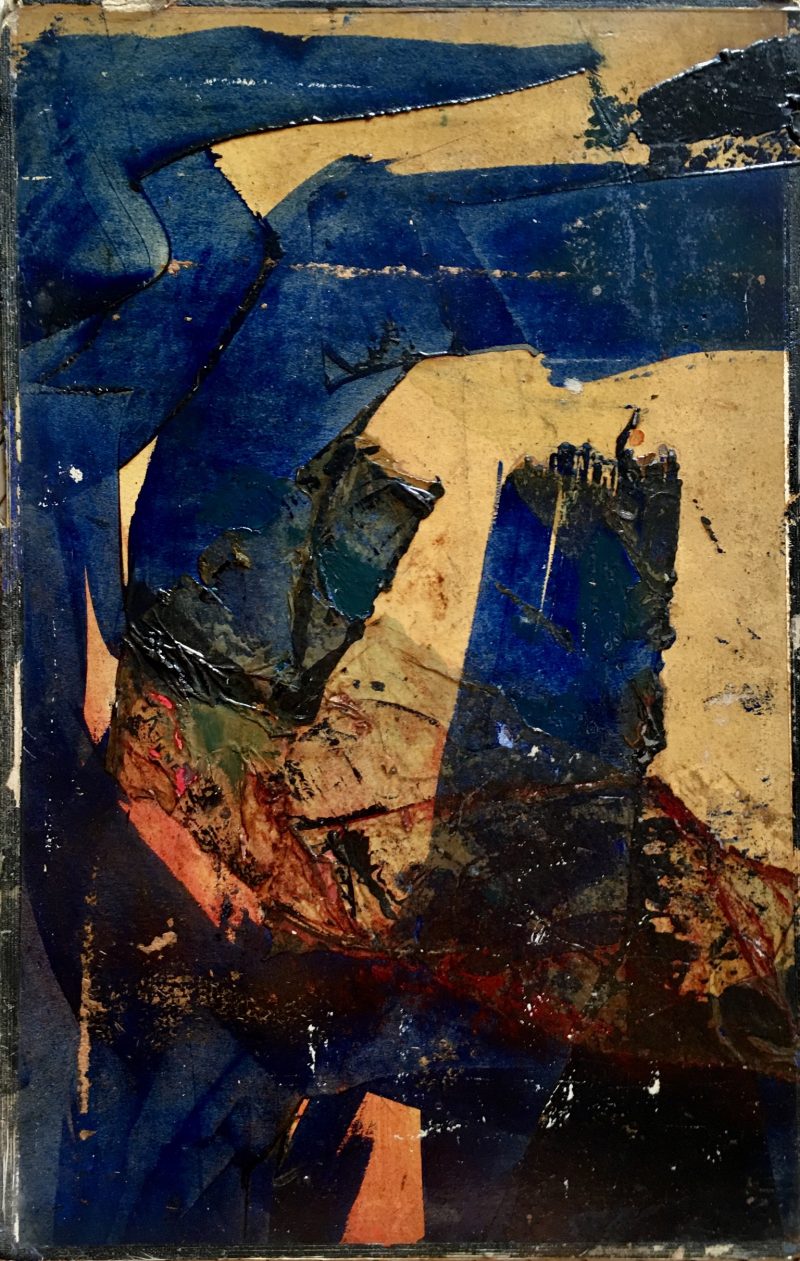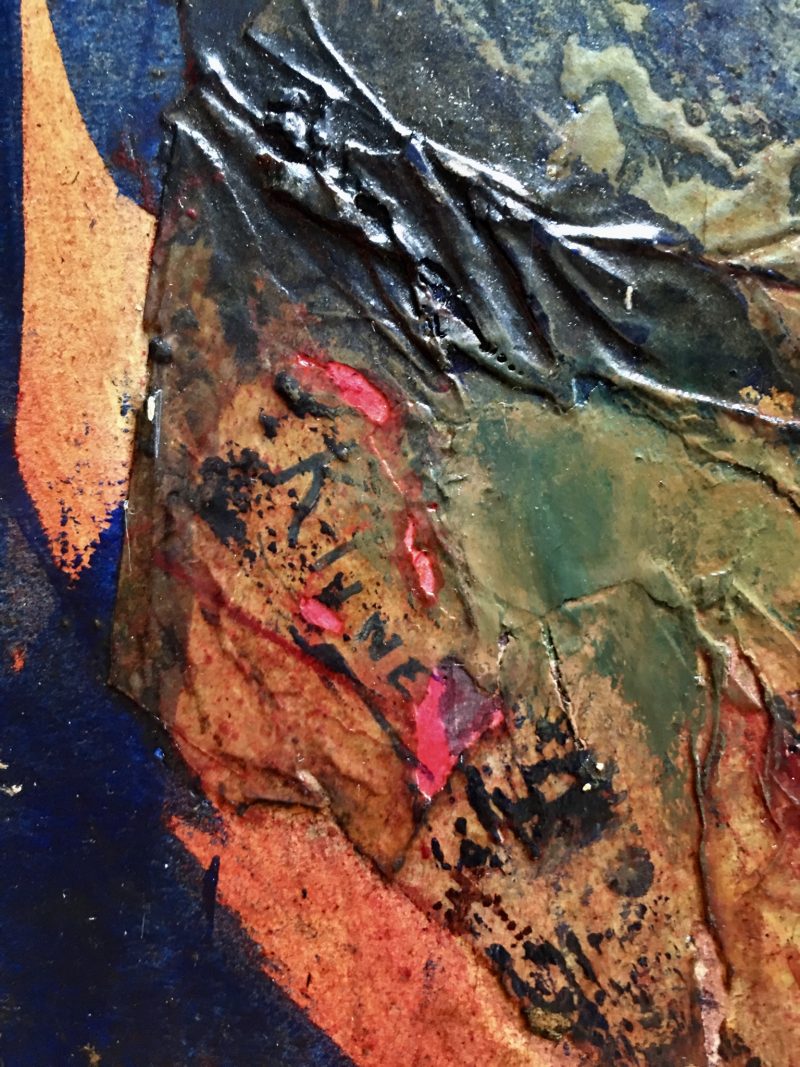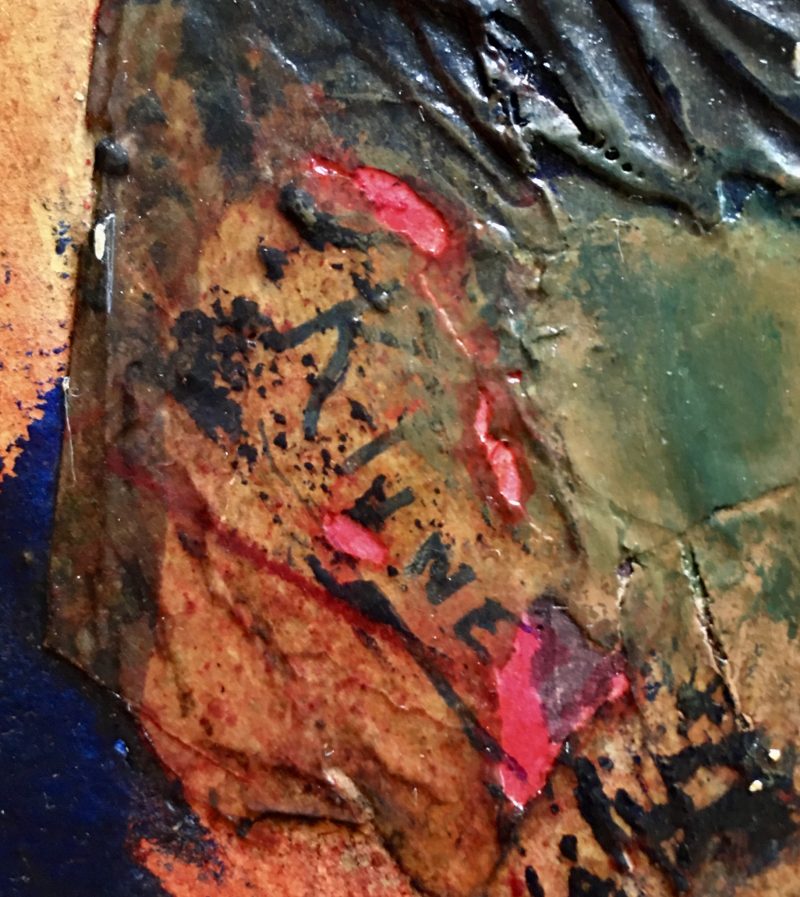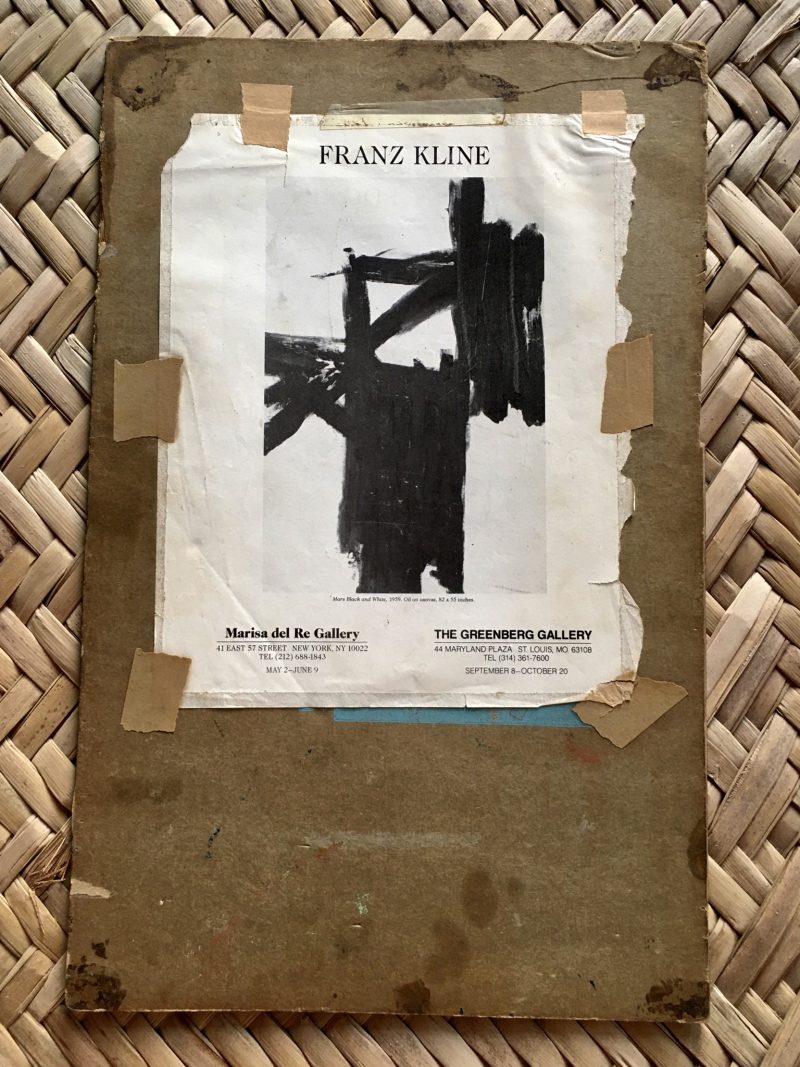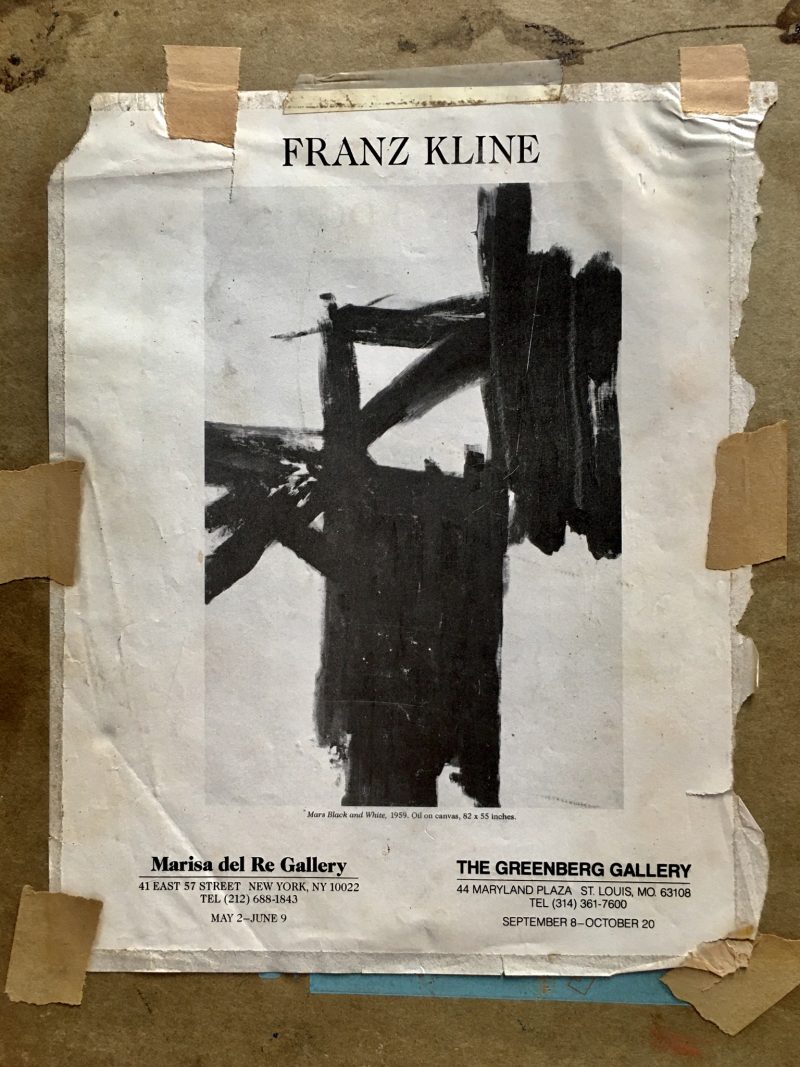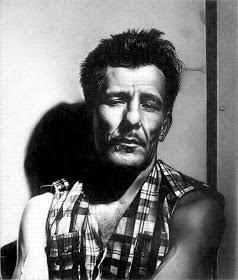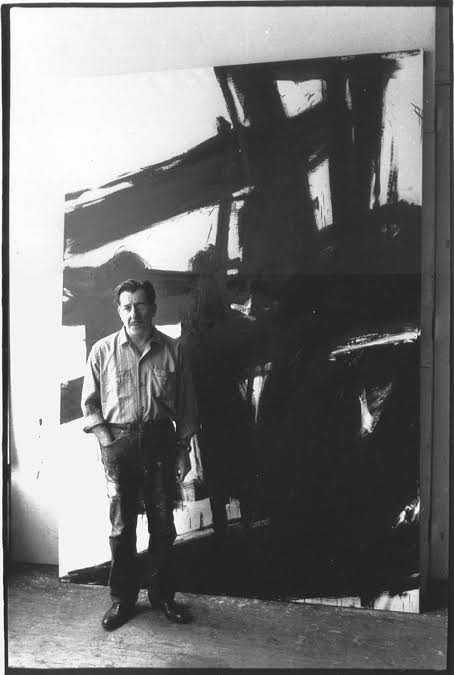SOLD. Mid Century Franz Kline Signed Oil on Board
Franz Kline Mid Century Bold Color Oil on Illustration Board, Signature in middle left. Measures 11 x 17.5 inches. In good condition except for some scuffs and signs of aging, but overall, a fantastic piece. Verso has an art magazine advertisement for the María del Re Gallery, New York & The Greenberg Gallery, St. Louis.
I acquired this beauty from the son of a private collector in Los Angeles, who’s father died in 1999 & left him hundreds of mid century artworks. A fascinating collection.
SOLD.
Possible Provenance: based on gallery advertisement taped on verso of artwork.
http://www.thegreenberggallery.com/about
Kline exhibited with The Greenberg Gallery from September 8, 1984 – October 27, 1984
http://www.thegreenberggallery.com/exhibitions/franz-kline
»
New York artist Franz Kline’s painterly style embodies the speed, action, and immediacy that characterized the Abstract Expressionist movement of the 1940s and 1950s. Though he began as a figurative painter, Kline developed his mature style by 1950, creating entirely abstract works devoid of representation. Focusing on black and white paintings in the first half of the decade, Kline increasingly re-introduced color into his palette in the mid-1950s and for the remainder of his career. Untitled (ZD 240) is a stunning example of one of Kline’s earliest experimentations with color, as thick swathes of greens, blues, reds and yellows extend across the composition, while drips of paint trickle down in overlapping forms. Kline’s interest in the value of contrast is readily apparent in the present lot – here, deep greens pop against bright reds, vibrant blues are juxtaposed against pinks, and soft yellows are situated against blacks. The sheet itself is entirely painted with an opaque, layered impasto surface, which showcases a boldness not typically likened to works on paper.
In describing Franz Kline’s oeuvre, renowned art critic Robert Goldwater noted in 1967 that the power of these works is “generated from within, by an immense internal unit, a swath or rectangle, a closed shape or a crossed one, that pushes and extends the perimeter until it has sufficient room to take its proper form” (Robert Goldwater, quoted in William S. Lieberman, An American Choice: The Muriel Kallis Collection, New York, 1981, p. 62). Untitled (ZD 240) exemplifies Goldwater’s view – the perimeter is marked on the upper and right edges by swaths of red and white. Yet rather than serve as boundaries, they seem to extend past the confines of the perimeter, pushing the composition outwards beyond its domestic scale. Furthermore, the bottom edge of the sheet is un-delineated, as Kline paints to the paper’s edge, allowing for drips of paint to fall beyond the border. Ultimately, the present lot confronts the viewer with Kline’s characteristic immediacy, yet what is most striking is the artist’s masterful use of color, which he continued to explore for the remainder of the decade. »
- Text from Phillips Auction, New York
- https://www.phillips.com/artist/5409/franz-kline
MARISA DEL RE Gallery
FOUNDER AND DIRECTOR OF “MARISA DEL RE GALLERY”
Marisa del Re founded and directed the “Marisa del Re Gallery” in New York City from 1969 to 2001, representing exclusive international artists: Arman, Karel Appel, Robert Indiana, Conrad Marca-Relli, Valerio Adami, Bettina Werner, Arnaldo Tomato, Jean Michel Folon, Sacha Sosno, Robert Cottingham, Kenzo Okada, Richard Pousette-Dart, DuaneHanson, George Tooker, Rodney Ripps, Robert Motherwell, KH Hodicke and others.
Her important contribution to the artistic and cultural life of New York is reflected in the organization of countless successful exhibitions, both in her gallery and in the most important American museums: Paul Klee, Wassily Kandinsky, Alexander Calder, Andy Wahrol, Giorgio De Chirico, Jean Arp, Lucio Fontana, Joseph Beuys, Tom Wesselman, George Segal, Jasper Jones, Roy Lichtestain, Robert Rauschenberg, James Rosenquist and others.
From 1978 to 1997, at the invitation of S.A.R. Prince Ranieri of Monaco, creates, directs and organizes the “Sculpture Biennial of Montecarlo” which sees the participation of all the greatest sculptors of the international scene, with monumental sculptures, set up in the most representative public spaces of the city. Her experience and expertise led her to be recognized as one of the most important figures in the international art market.
https://www.canovaprize.com/marisa_delre.asp
CURRENT RESEARCH: to date, the artwork has not been refused as authentic, but has not been legally/offically declared authentic by an approved organisation. Also, some authentification firms charge as much as USD$3500 to simply see the work / SEE EXAMPLE HERE: https://richardpolskyart.com/submitting-electronically/
More Overall Research & Signature Verification:
http://www.freemanart.ca/FranzKline.htm
https://www.artexpertswebsite.com/pages/kline.php
https://www.icollector.com/Painting-V-Oil-on-Paper-Franz-Kline_i27338808
https://www.icollector.com/Franz-Kline-American-1910-1962-Oil-on-Canvas_i29656701
https://www.artexpertswebsite.com/pages/kline.php
https://worthingtongalleries.com/franz-kline-1910-1962/
RESPONSE from this website: http://www.hauserwirthinstitute.org/programs/franz-kline-catalogue-raisonne/
+++
QUOTE: June 6, 2021
Dear Guy Berube,
Thank you very much for your interest in the catalogue raisonné project Franz Kline Paintings, 1950–1962. I am writing to confirm that your submission has been received. At this time, we are focusing strictly on Kline’s oil-on-canvas paintings executed between 1950 and 1962. It is possible that Kline’s works on board, panel, and paper will be included in future stages of the catalogue raisonné project. We will keep your submission in reserve for any such developments.
Thank you again for your submission.
Kind regards,
Scout Hutchinson
Research Assistant
Franz Kline Paintings, 1950–1962
www.hauserwirthinstitute.org
Franz Kline (May 23, 1910 – May 13, 1962) was an American painter. He is associated with the Abstract Expressionist movement of the 1940s and 1950s. Kline, along with other action painters like Jackson Pollock, Willem de Kooning, Robert Motherwell, John Ferren, and Lee Krasner, as well as local poets, dancers, and musicians came to be known as the informal group, the New York School. Although he explored the same innovations to painting as the other artists in this group, Kline’s work is distinct in itself and has been revered since the 1950s.
| Franz Kline | |
|---|---|
| Kline, c. 1960 | |
| Born | Franz Kline May 23, 1910 Wilkes-Barre, Pennsylvania |
| Died | May 13, 1962(aged 51) New York City, New York |
| Nationality | American |
| Education | Boston University |
| Known for | Abstract painting |
| Movement | Abstract expressionism, action painting |
Franz Kline, Painting Number 2,1954, The Museum of Modern Art
Biography
Kline was born in Wilkes-Barre, a small coal-mining community in Eastern Pennsylvania. When he was seven years old, Kline’s father committed suicide. During his youth he moved to Lehighton, Pennsylvania and graduated from Lehighton High School. His mother later remarried and sent him to Girard College, an academy in Philadelphia for fatherless boys. After graduation from high school, Kline studied art at Boston University from 1931 to 1935, then spent a year in England attending the Heatherley School of Fine Art in London. During this time, he met his future wife, Elizabeth V. Parsons, a British ballet dancer. She returned to the United States with Kline in 1938.
Upon his return to the country, Kline worked as a designer for a department store in New York state. He then moved to New York City in 1939 and worked for a scenic designer. It was during this time in New York that Kline developed his artistic techniques and gained recognition as a significant artist.
He later taught at a number of institutions including Black Mountain College in North Carolina and the Pratt Institute in Brooklyn. He spent summers from 1956 to 1962 painting in Provincetown, Massachusetts, and died in 1962 in New York City of a rheumatic heart disease, ten days before his 52nd birthday.
Artistic development
Early work
Kline’s artistic training focused on traditional illustrating and drafting. During the late 1930s and early 1940s Kline worked figuratively, painting landscapes and cityscapes in addition to commissioned portraits and murals. His individual style can be first seen in the mural series Hot Jazz, which he painted for the Bleecker Street Tavern in Greenwich Village in 1940.
The series revealed his interest in breaking down representative forms into quick, rudimentary brushstrokes.
The personal style he developed during this time, using simplified forms, became increasingly more abstract. Many of the figures he depicted are based on the locomotives, stark landscapes, and large mechanical shapes of his native, coal-mining community in Pennsylvania. This is sometimes only apparent to viewers because the pieces are named after those places and objects, not because they actually look like the subject. With the influence of the contemporary New York art scene, Kline worked further into abstraction and eventually abandoned representationalism. From the late 1940s onward, Kline began generalizing his figurative subjects into lines and planes which fit together much like the works of Cubism of the time.
In 1946 the Lehighton, Pennsylvania Post of the American Legion commissioned Kline to do a large canvas depicting the town where he had attended high school. The mural Lehightonwas acquired from the American legion post in 2016 by the Allentown Art Museum in Allentown, Pennsylvania and is today on permanent exhibition there.
Later work
It is widely believed that Kline’s most recognizable style derived from a suggestion made to him by his friend and creative influence, Willem de Kooning. De Kooning’s wife Elaine gave a romanticized account of the event, claiming that, in 1948, de Kooning advised an artistically frustrated Kline to project a sketch onto the wall of his studio, using a Bell–Opticon projector. Kline described the projection as such:
“A four by five inch black drawing of a rocking chair…loomed in gigantic black strokes which eradicated any image, the strokes expanding as entities in themselves, unrelated to any entity but that of their own existence.”
As Elaine de Kooning suggests, it was then that Kline dedicated himself to large-scale, abstract works. However, even though Willem de Kooning recalls that Kline delved into abstraction “all of a sudden, he plunged into it”, he also concedes that it took considerable time, stating that “Franz had a vision of something and sometimes it takes quite a while to work it out.” Over the next two years, Kline’s brushstrokes became completely non-representative, fluid, and dynamic. It was also at this time that Kline began painting only in black and white. He explained how his monochrome palette was meant to depict negative and positive space by saying, “I paint the white as well as the black, and the white is just as important.” His use of black and white is very similar to paintings made by de Kooning and Pollock during the 1940s.[10]There also seem to be references to Japanese calligraphy in Kline’s black and white paintings, through his exchange with the Japanese avant-garde calligraphy group Bokujinkai and its leader Morita Shiryu, although Kline later denied that connection.
Kline’s first one-man show took place on October 16 – November 4, 1950, at the Egan Gallery, 63 East 57th Street. The show consisted of eleven abstract paintings. Color was a rare element in the paintings: brown underpainting near the bottom of Nijinsky and fleeting hints of green in Leda. The paintings displayed a variety of compositions and moods, but they all had one defining trait: Kline’s signature style of black on white. Thirteen years earlier in London, Kline had called himself a “black and white man” but not until this show had the accuracy of this phase become clear to others. Because of Kline’s impact and his concrete style, Kline was dubbed the “black and white artist”, a label which stuck with the artist, and which he would occasionally feel restricted by. Kline’s first one-man show was a pivotal event in Kline’s career as it marked the virtually simultaneous beginning and end of Kline’s major invention as an abstract artist. At the age of forty, Kline had secured a personal style which he had already mastered. There were no real ways for Kline to further his investigation; he only had the potential to replicate the style he had already mastered. To move on, there was only one logical direction for Kline to go: back to color, the direction he was headed at the time of his premature death from heart failure.
In the later 1950s, in such paintings as Requiem (1958), Kline began experimenting with more complex chiaroscuro instead of focusing on a strict monochromatic palette. Then in 1958, he reintroduced the use of color in his work through colorful accents in his black and white paintings. This exploration back to color-use was still in development when Kline died in 1962.

